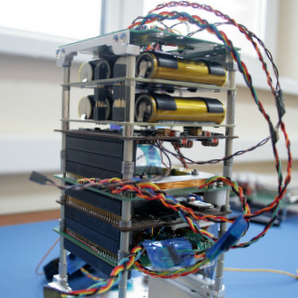
English > News
Dynamic tests of the scientific equipment 'Contact' have been completed in SSAU
31.07.2015, 13:05
The scientists of Samara State Aerospace University have completed dynamic tests of the first Russian university nanosatellite “SamSat-218D” created by SSAU students.
The tests were conducted on a vibration testing table, where vibration strength and vibration resistance of a nanosatellite components and body are being checked. At the same time a load factor affects the device under the same conditions as at the stage of launching by the carrier rocket “Soyuz”.
The nanosatellite “SamSat-218D” is a part of the scientific equipment complex “Contact”. The second part of “Contact” will be placed on board of a small spacecraft “Aist-2”. It has already passed the whole set of tests and transferred to the Rocket and Space Centre “Progress”.
Both satellites are created by the scientists and engineers of SSAU and the Rocket and Space Centre “Progress”. The spacecraft launching into orbit will take place within the framework of the first launch campaign of the new Russian space-launch complex Vostochniy.
One of the goals of the complex “Contact” is the development of the management technology for the processes that take place on board by a mobile device, bypassing the Mission Control Centres connected to a mobile satellite communication GlobalStar. The experiment authors are going to “call” on board with the use of a mobile terminal and to receive the necessary telemetric information on the flight progress.
This technology developed by the team of SSAU Interuniversity Department of Space Research will enable to create a spacecraft control system even under the conditions when they are out of range of the land-based Mission Control Centres.
According to the Project leader Professor Igor Belokonov, the proposed technology of interaction with the spacecraft is very important for the future developments. “The similar experiment was first conducted in 2005 on the satellite TNS-0. The communication via existing commercial low-altitude satellite networks is very promising and could be used to create commercial as well as scientific and educational groups of nanosatellites. By creating the groups of coordinated nanosatellites flying and sharing information, the scientists will have the opportunity to solve the problems that are often beyond the power of a single device. In particular, SSAU participates in the international project QB-50, in which the grouping of the 50 nanosatellites will study the geophysical conditions in near-Earth space”- noticed Igor Belokonov.
The whole test cycle of the nanosatellite “SamSat-218D” (Module “Contact-Nanosatellite") will be completed in July. The tests are being conducted on the basis of SSAU Interuniversity Department of Space Research, as well as the Centre for nanosatellites testing and complex mining, located in the housing EIK-3 of the Rocket and Space Centre “Progress” in the SSAU territory.









